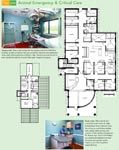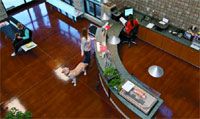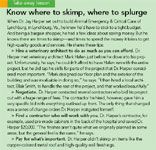Designing on a dime
Perfect timing, expert advice, and the owner's eye for bargains makes the new facility for Animal Emergency & Critical Care of Lynchburg in Lynchburg, Va., a source of client satisfaction-and financial success.
Dr. Jay harper never set out to be an emergency and critical-care veterinarian. Instead, chance events put him on a path that would change his career.
Dr. Harper, a 1998 graduate of Virginia-Maryland Regional College of Veterinary Medicine, was working in a small-animal practice in Virginia when his roommate introduced him to the idea of emergency medicine. For a little extra money and experience, Dr. Harper pitched in at his roommate's practice on Friday nights and found that he really liked the medicine he practiced there. Then, when his roommate booked an interview at an emergency facility an hour away, Dr. Harper agreed to ride along. As fate would have it, his roommate wasn't interested in the job—but Dr. Harper was. And the practice owners were interested in him.

As a young grad with his heart set on small-animal general practice, Dr. Harper never would've guessed that just seven years later he and his wife, Rebecca, would build their own brand new emergency and critical-care facility—a facility that earned him a 2006 Veterinary Economics Hospital Design Competition Merit Award.
The right place at the right time
When Dr. Harper and Rebecca took over Animal Emergency & Critical Care of Lynchburg in Lynchburg, Va., in 2001, they vowed they would build a new facility when the five-year lease expired. But they didn't quite make it that long. A traveling ophthalmologist, while visiting the practice, pointed out that the time to move was probably sooner than they had thought—as evidenced by the stacks of boxes and equipment towering high overhead in the surgery suite.
"That's when we realized he was right; we had already outgrown our facility," says Dr. Harper. The 60-year-old converted insurance building didn't fit the bill any longer.

With a small budget—less than $1 million—the couple had a hard time finding real estate that suited them. Then Rebecca began attending real-estate auctions, and soon found out about a piece of property up for grabs that looked too good to be true. It was on a busy, well-lit road, easy to access, already zoned for veterinary use, and near many other 24-hour businesses, making it a perfect neighborhood for an after hours critical-care facility.
"Our bank approved us to bid up to $160,000 for the land," Dr. Harper says. "The day of the auction, four of us were bidding. And by a stroke of luck, we won the auction—for exactly $160,000, even though it was valued at $300,000. It didn't feel real that we'd just bought a piece of property. But we've always been good at taking opportunities as they come and this time was no different. That night, we knew we were meant to build this practice."

The culture of critical-care design
The Harpers didn't need to worry about boarding, grooming, dental suites, and many other aspects typical of a small-animal hospital because of the nature of their facility. However, their niche brought a different set of design issues. For example, Dr. Harper says they needed to include central surgical suction, central oxygen and other medical gases, and many electrical outlets. And the building needed to be gurney-friendly from front to back.
"I also wanted to design a hospital that would put clients at ease and instill confidence in us right away," Dr. Harper says. "Clients who come here have often never visited before and don't know us. And they may not even understand how an emergency facility works."

A look at the numbers
To help conquer this challenge, Dr. Harper and his architects, Mark Hafen of Animal Arts in Boulder, Colo., and Blair Smith of Dominion Seven Architects in Lynchburg, Va., came up with the idea of making the practice transparent. This led to the design element of windows peeking from the parking lot straight into the surgical suite. "Staff members initially voiced concerns about working in a fishbowl," he says. "Our answer was, 'don't do anything in front of a window you wouldn't want someone to see.' We often have clients pull into the parking lot at night to watch an ongoing surgery."
Dr. Harper had clients in mind when he included the trauma room, too. Essentially one of five exam rooms, the trauma room features a wall-mounted patient monitor, anesthesia hookups, IVs, a power gurney, and more. "If a client comes in feeling frantic with an injured pet, we can let him or her stay with the pet while we start treatment," says Dr. Harper. "If clients can participate in their pet's care, it helps ease their anxiety."

Reception area: Dr. Harper chose a custom-made curved reception desk, stone that mimics the exterior of the hospital, and liberal views of the outdoors to give the reception area a warm, inviting feel. Automatic doors that swing wide enough for gurneys to pass through ease entry into the facility during emergencies. The staff lounge overlooks the reception area, so staff members can keep an eye out for problems even on break.
And a new lab helps the team be more attentive. Because one doctor and one technician often work overnight, running lab work to an out-of-the-way lab means leaving the treatment area unmanned for a considerable amount of time. "At our old facility, our lab was upstairs," he says. "Now our lab alcove is just off treatment, which works perfectly. The glass walls looking toward isolation, surgery, and the patient ward allow the doctor and technician to do nearly everything and still feel in control of what's going on elsewhere."
eBay: Not just for cheap DVDs
An anesthesia machine that retails for $20,000: bought on eBay for $1,200. Surgery lights that retail for $15,000: bought on eBay for $1,200. A $3,000 vacuum pump: bought on eBay for $64. Saving nearly $100,000 by bargain shopping on eBay and at auctions: priceless. "I'm an eBay junkie," Dr. Harper says. "Once I figured out you could buy medical equipment from online auctions as well as from government auctions, I bought all sorts of nearly brand new medical equipment for 10 cents on the dollar."

Know where to skimp, where to splurge
Dr. Harper even bought props from the Spider-Man 2 movie, such as kick buckets, monitor mounts, and oxygen lines, at a greatly reduced cost. The items, donated to a charity that auctioned them on eBay, came with a certificate of authenticity—and they work well in the practice, he says.
Keep in mind, however, that in some cases you'll want to buy from a distributor to guarantee a warranty, service agreements, and such, Dr. Harper warns. "If you buy cheap, then get mad that the item breaks, you shouldn't be buying things this way," he says. "And for me, certain big-ticket items and those that are veterinary-specific are best purchased from the distributor to guarantee your investment. But for the most part, I've gotten good deals from these auctions and saved the practice a ton of money. And I enjoy it."
Enlarge facility, enlarge practice
With this new facility, the Harpers went from a cramped 1,600-square-foot practice to a spacious 6,300-square-foot facility. They now have room to grow. "One unexpected side effect: I started wearing more comfortable shoes in order to get around," Dr. Harper quips.
All kidding aside, Animal Emergency & Critical Care of Lynchburg grew 20 percent its first year. Dr. Harper attributes this to a combination of increased fees, the new location—which is safer and more appealing than the former location—and the beautiful new practice.
"It's been a night-and-day difference since we moved," Dr. Harper says.
Sarah A. Moser is a freelance writer and editor in Olathe, Kan. Please send questions or comments to ve@advanstar.com.